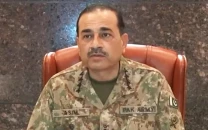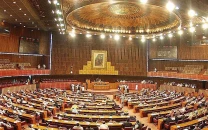One month later: Baltistan village residents live in fear, trauma
As NGOs and social workers provide relief, villagers call upon the govt to aid them.

“The magnitude of destruction was colossal and people are still passing through the ordeal,” said Tahir Rana, a social worker who recently visited the village.
According to information gathered by various non-governmental organisations (NGOs), the floods destroyed at least 131 houses, 30 shops, 12 water channels, two schools, a seminary, a bridge and a seven-kilometre road.
The floods also had a profound impact on the agricultural sector, as they washed away standing crops on 400 acres, destroyed 3,450 fruit and 12,500 other trees in the area. It has been estimated that 900 people have been rendered homeless as a result of the disaster.
Keeping in mind the large-scale destruction, the government had initially declared the place “unfit for rehabilitation”, but the villagers were reluctant to relocate elsewhere.
However, Muhammad Iqbal, a local political representative, insists that the village is not worth living anymore, as landslides and flash floods have become a “routine”.
He has requested the government to arrange a permanent accommodation for the displaced people.
The mountainous Talus village, which is located in Ghanche district, was also affected by last year’s floods, which killed 13 villagers. This year one person has gone missing due to the floods; widespread destruction has caused a lot of panic among people, who are faced with several psychological problems in the aftermath of the disaster.
“People have developed extreme psychological trauma after seeing their houses washed away by the floods,” said Rana, a resident of Talus.
He explained that a local woman Safoor fell unconscious due to fear, and is yet to regain her consciousness. Another woman Nissa also lost her senses last month due to extreme psychological pressure, he added.
People recalling the “nightmare” said that they felt they had turned deaf as soon as the lightning struck the mountain with a thunderous voice.
“I rushed to a mosque as soon as I heard the noise and warned people of floods through a loudspeaker,” said Lumberdar Mohammad Kacho, adding that only God had saved their lives.
Meanwhile, the villagers have appreciated Deputy Commissioner Fazal Khaliq and Pakistan Red Crescent Society (PRCS) Chairperson Asif Hussain for their dedication in providing relief to the people.
Earlier this month, PRCS sent a relief consignment for over 200 families who had suffered as a result of landslides in the region. Hussain plans to spend his Eid with the flood victims to console them. The villagers also appreciated PRCS for providing alternate schooling to children in the village where the army launched a large-scale rescue and search operation soon after the disaster.
District Health Officer Dr Ghulam Mehdi added that they had set up a free medical camp for the victims since the first day of the tragedy’ lady health workers are also working in the camp and had conducted four deliveries so far, he said.
The villagers, however, are not fully satisfied with the pace of rehabilitation work. According to a villager, Haji Hassan Mohammad Ibrahim, they had received tents and other relief items donated by NGOs. He requested the government to provide assistance to them as they could not rebuild the houses on their own.
Published in The Express Tribune, August 22nd, 2011.



















COMMENTS
Comments are moderated and generally will be posted if they are on-topic and not abusive.
For more information, please see our Comments FAQ